As is made clear by the numbers standing behind me the bar wholeheartedly welcomes this appointment, and, I take great pleasure in extending congratulations and best wishes to your Honour.
As a barrister your Honour won a reputation as an intelligent and tenacious advocate who on even the worst of days was a worthy and always honourable adversary. More than most you seemed to put your very heart into your cases. Despite this and the way you sympathized with most of those you represented, these features never seemed to cloud your judgment. Having observed your Honour for some time I am left with the impression that despite the fact that your talents and achievements caused large insurers and media businesses to beat a path to the door of your chambers, you were most comfortable when acting for people and best of all for those who were least able to fend for themselves. Evidence of this came only yesterday when your Honour with evident pride told me how satisfying you had found it that your last appearance in a court had been that mentioned by the Attorney General where you represented a couple who had lost something dear to them.
I endorse the comments of the Chief Justice and of the Attorney General concerning your qualifications which fit you for this important new role. This appointment adds to the high standing of the court.
Though you have spent the majority of your life studying or practicing law your Honour can be seen to be the product of many other influences.
We are always moulded by our parents and siblings but your Honour has enjoyed an especially close bond with your irrepressible mother, Val, your more laconic but equally sage father, Dave and your sister Larelle. All three will be justifiably proud today.
The next influence seems to have been your Honour’s powerful masculinity. When recently your Honour’s wife and three daughters came to choose a new family pet, it clearly was thought that the gender balance in the house was imperfect and a female puppy was chosen. This proved insufficient to balance the scales so that when it was discovered that the family dove was male, this inconvenient fact was simply ignored and it was christened Ruby. All of this shows that your Honour has benefited from a life within a family whose members have completely different interests and who employ a healthy scepticism for your views. Near as these, your closest supporters, are to you and despite your devotion to them, your Honour can count on this advantageous situation persisting.
I have always seen a lot of sense in President Truman’s advice that “you can get a lot done in life if you don’t try to claim the credit” and your Honour seems to embody this approach. One example of this is the way many of the standard opinions and draft submissions used by the volunteers of the Queensland Council of Civil Liberties today were prepared by you pro bono without seeking any recognition. Another happened a long time ago but has lasting repercussions for the life of students of the University of Queensland. It was in the seventies and the Senate of the University was called on to decide whether the funding by the student union of a proposed public interest research group fell within the usual objects of a University. The real issue was whether the union could provide funds to mount a political campaign in support of the right to protest. The Senate resolved to approve the proposal but only after it had received what I am assured was a brilliant and spirited submission which persuaded the Chancellor, Mr Justice WB Campbell to use his casting vote to break a 13 all deadlock. The submission argued for freedom of expression and that it was an essential and natural part of the function of a university to engage in debate about broader issues than strictly relevant to student life and became famous. The author of the submission sought no credit for it. He was your Honour. This characteristic suggests a humility or lack of ambition for personal advancement that can only make for a better Judge.
One of the many pleasures that come with occupying my position is the enthusiastic co-operation shown by people consulted for biographical detail to be included in speeches such as this. Your Honour’s case has been no exception. In fact it is unique in that I have had access to the opinions on your Honour’s fitness for office from your life long friend and respected psychiatrist, Dr Peter Hoey. Firstly his view is that while the usual risks to anyone assuming a mantle of responsibility and power lie largely in the direction of increasing megalomania there is little chance of that in your case. Secondly he expressed concern that in pursuing a successful career as a barrister, your Honour has sublimated your true vocation as a double for Bryan Ferry, the lead singer of Roxy Music. Apparently ever since your teenage years you showed an uncanny ability to sing with the precise tone, timbre and insouciance of the man who was surely the most suave of rock stars. Your Honour quickly learned all the lyrics of the songs that made up the album “Country Life” and could have stood in for Mr Ferry at the drop of a hat. Dr Hoey’s concern is that repression of this side of your Honour’s personality may be damaging if allowed to continue and he counsels sessions in which your Honour is encouraged to give full vent to your favourites, “The Thrill of It All” and “These Foolish Things”.
Finally Dr Hoey’s diagnosis is that your strong sense of duty and fairness may predispose your Honour to worrying too much about the cases you must decide. If, on your retirement from this court, that is the worst that can be said of your Honour, the litigants of Queensland will be well satisfied.
Your Honour and your family are entitled to savour this occasion. The bar shares in your enjoyment and in this recognition of this new and most important milestone in your legal career. We wish you very well in this new role.
I also add the Bar’s congratulations to those extended by the Chief Justice to your Honour Justice Atkinson on completing your first decade as a Judge of this court.
May it please the court.
Members are invited to respond to the request of the President, Michael Stewart SC, to provide your views regarding the new building on the Forum. Please click on the link below.
CLICK HERE
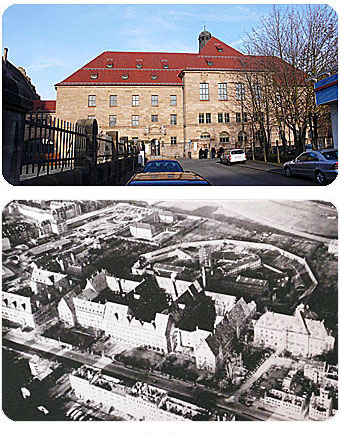 The first photograph shows the court house. The court room used for the trial is on the top floor, central section with large windows.
The first photograph shows the court house. The court room used for the trial is on the top floor, central section with large windows.
A widely held belief is that Nuremberg was chosen as the venue for the trials because it had been the venue for the Nazi party rallies in the 1930s. Staff at the court house advance a difference thesis: they contend it was the only court house of sufficient size to host such a trial that was intact at the end of the war. The two theories are not inconsistent. Support for the thesis advanced by the staff at the court house appears in the second photograph. This is a photograph of a photograph displayed within the court house that shows the court and adjacent prison complex at the end of the war. One can see that it is unscathed. (Nuremberg itself had been destroyed so extensively that there was debate as to whether it was better to rebuild the town on another site, rather than try to rebuild on the original site. The latter option was chosen and the reconstruction of the town has followed closely the pre-war design.)
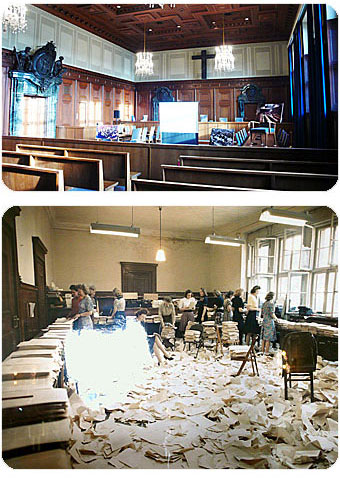 The third photograph shows the actual court room as it is now. It was remodelled partially for the war crimes trials and has been remodelled again since then. The crucifix is a feature found in other Bavarian court rooms. Obviously, the doctrine of the separation of Church and State is not entrenched in Bavaria in the way that it is here.
The third photograph shows the actual court room as it is now. It was remodelled partially for the war crimes trials and has been remodelled again since then. The crucifix is a feature found in other Bavarian court rooms. Obviously, the doctrine of the separation of Church and State is not entrenched in Bavaria in the way that it is here.
Readers may have noticed that images of the trials show defendants seated in the dock wearing sunglasses. This was not some trendy fashion statement! They did this because of the extremely strong fluorescent lighting installed for the hearing. Artificial lighting was required because the windows had been sealed for security reasons. That lighting was strong because the proceedings were filmed.
The fourth photograph is of a photograph displayed within the present Court complex amongst a series of photographs related to the trials and the destruction wrought on Nuremberg by the Allied bombing. Plainly, filing was not a strong point! To the orderly Germans, such an image must reflect poorly on the Allies.
Understandably, that series of photographs did not include a photograph of the dead bodies of the defendants sentenced to death. The matter is mentioned because readers may recall the controversy about Iraqi state television broadcasting images of the moments leading up to the execution of Saddam Hussein at the end of 2006 and, after his execution, of his shroud wrapped body. Rightly or wrongly, there was precedent for publication of the image of his dead body. Following the trials in this Court room, photographs of the dead bodies of the executed defendants appeared in the print media. A sample of the publication is on public display in a museum in Nuremberg.
Andrew Lyons

Note: The perspectives featured above are indicative only, and are subject to change.

Site analysis
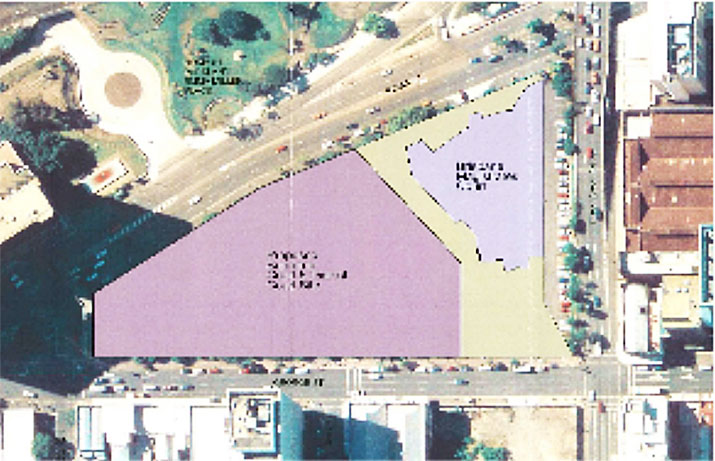
Court Site Location Plan
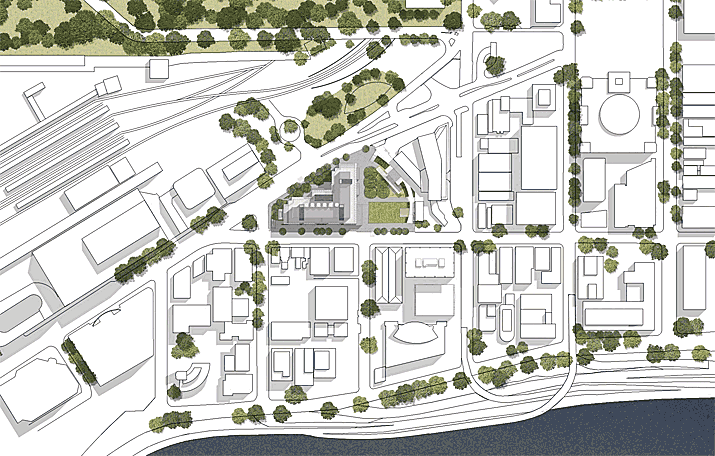
Site Plan

Ground Floor Plan
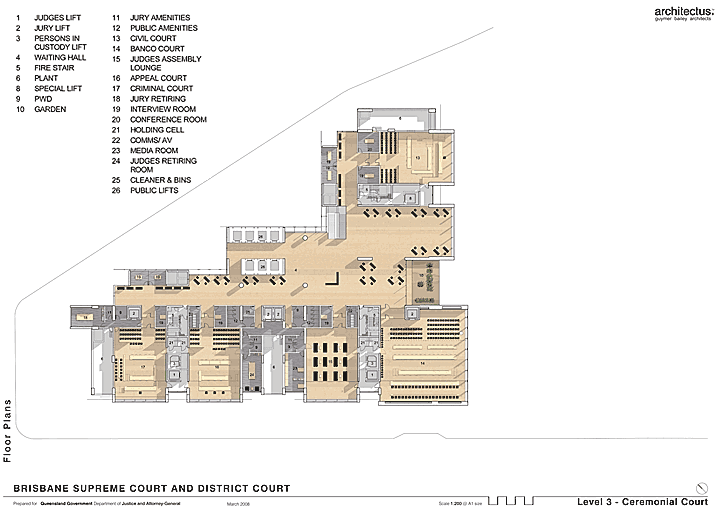
Level 3 – Ceremonial Court – Floor Plan
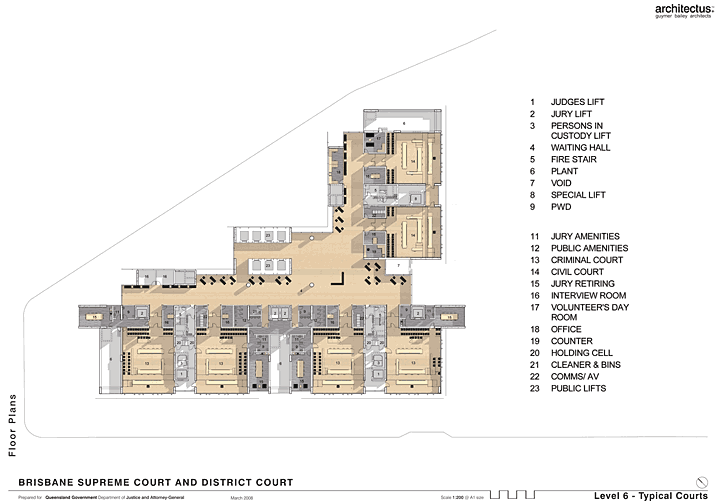
Level 6 – Typical Court Floor Plan
Note: The plans featured in this article are indicative only, and are subject to change.
Criminal and civil sittings of the New South Wales Supreme Court on circuit were held in Brisbane from 1850 to 1856 and, in 1857, a Resident Judge was appointed to Moreton Bay. At separation on 10 December 1859 the only judge in Queensland was a judge of the Supreme Court of New South Wales, exercising jurisdiction in what had previously been the District of Moreton Bay and was then the colony of Queensland.
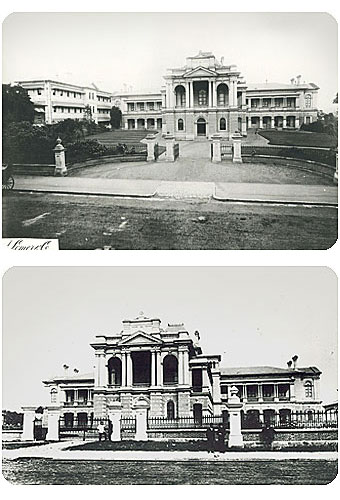 The Supreme Court of Queensland was formerly established under the Supreme Court Constitution Amendment Act 1861. Under the provisions of that Act, the Supreme Court of Queensland was to be a court of record to be held at Brisbane and the full powers and legal jurisdiction of the Supreme Court of New South Wales were retrospectively transferred to the Supreme Court of Queensland under the Supreme Court Act 1863.
The Supreme Court of Queensland was formerly established under the Supreme Court Constitution Amendment Act 1861. Under the provisions of that Act, the Supreme Court of Queensland was to be a court of record to be held at Brisbane and the full powers and legal jurisdiction of the Supreme Court of New South Wales were retrospectively transferred to the Supreme Court of Queensland under the Supreme Court Act 1863.
Interestingly, from the date of separation, official notices, appointments of court officers, and Rules of Court were gazetted under the title “Supreme Court of Queensland” and although the seal of the Moreton Bay Court continued in use until 1861, the Court was referred to as the “Supreme Court of Queensland”. As such, it has been said, “the Acts of 1861 and 1863 simply gave statutory effect to an established political and juridical fact”.
In 1874, the Colonial Architect drew plans for the original building that housed the Court, and construction commenced two years later. The building was officially opened on 6 March 1879. Although photographs of the building are all that survive today, they leave little room for doubt that the first home of the Supreme Court was a magnificent edifice.
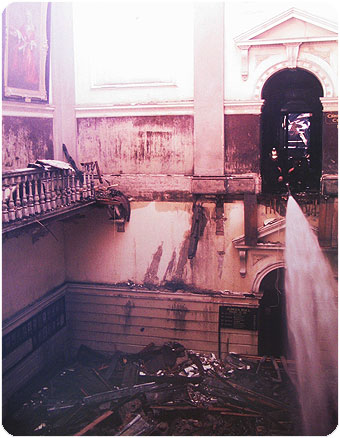 In the 1960s, it was decided to replace the original building with a modern multi-story structure but its end was hastened on 1 September 1968 when an arsonist set fire to it with the consequence that much of it was destroyed. This event is the subject of a SCLQ Exhibition currently on display in the Rare Books Precinct on Level 2 of the Complex.
In the 1960s, it was decided to replace the original building with a modern multi-story structure but its end was hastened on 1 September 1968 when an arsonist set fire to it with the consequence that much of it was destroyed. This event is the subject of a SCLQ Exhibition currently on display in the Rare Books Precinct on Level 2 of the Complex.
The surviving parts of the building were demolished in October 1976, and the existing Complex was constructed in two stages. The first was built in the 1970s on the western side of the site and housed the Supreme Court alone. Subsequently in the early 1980s the eastern and larger wing of the Complex was opened and the Supreme Court was relocated to this part. The District Court was then relocated from the Central Courts Building in North Quay to the part of the Complex formerly occupied by the Supreme Court.
If construction of the new Supreme and District Courts Complex is completed on schedule in 2011, its opening will coincide with the 150th Anniversary of the Supreme Court.
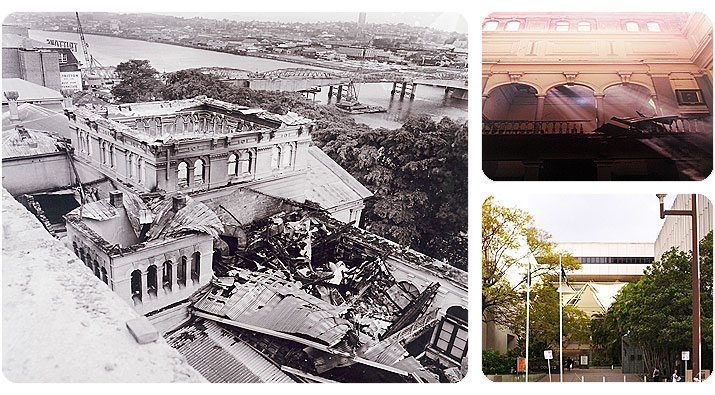
All photographs have been reproduced with permission from the collection of the Queensland Supreme Court Library.
In addition, the pedestrian and bicycle bridge currently under construction – the Tank Street Bridge – will radically change the urban usage pattern within the precinct.
The bridge will offer expansive views of the river, and will feature two large viewing and relaxation platforms, two rest areas, and a continuous all-weather canopy for the entire length of the bridge. Its design – incorporating as it does an artistic array of cables and flying struts — is reminiscent of the ropes and spars of sailing ships and boats.
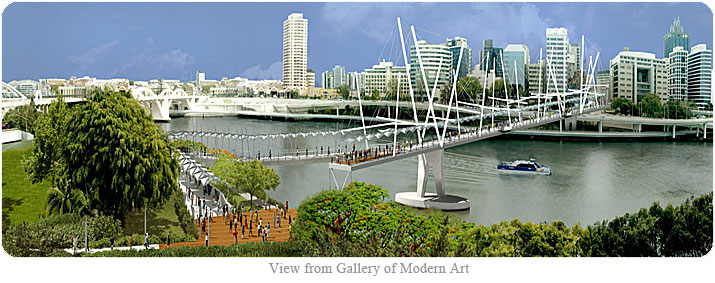 The public square will therefore not solely function as an open square between the new Complex and the Magistrates Courts building, it will become the logical termination of the Tank Street pedestrian axis across from Southbank and, as such, will become the marshalling point for what will become the major pedestrian gateway to the CBD.
The public square will therefore not solely function as an open square between the new Complex and the Magistrates Courts building, it will become the logical termination of the Tank Street pedestrian axis across from Southbank and, as such, will become the marshalling point for what will become the major pedestrian gateway to the CBD.
 Currently over 50,000 people cross the Goodwill Bridge each week and it is expected that at least this number will traverse the Tank Street Bridge and, in the process, walk past the highest courts in the State.
Currently over 50,000 people cross the Goodwill Bridge each week and it is expected that at least this number will traverse the Tank Street Bridge and, in the process, walk past the highest courts in the State.
The Tank Street Bridge will also link the city centre and South Brisbane and complete a pedestrian and bicycle loop linking the city and South Bank via the Goodwill Bridge. The Tank Street Bridge will stretch from the North Quay end of Tank Street to Kurilpa Point in South Brisbane, adjacent to the Gallery of Modern Art.
The axis will then be continued by the proposed Roma Street pedestrian bridge and through proposed landscape works in Albert Park up to the Wickham Terrace Observatory.
The Gallery of Modern Art, which was designed by Architectus, also acknowledges the city grid and axis of Tank Street to the historic windmill, whilst maintaining the river connection for the west end district.
The Gallery is therefore not only the largest cultural project to be undertaken in Queensland’s recent history, it stands on the other side of the river as a perfect complement to the new Courts Complex.
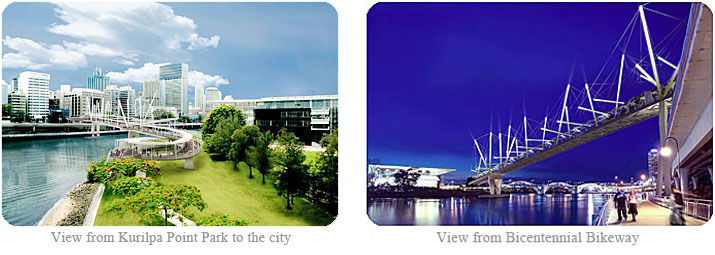
Note: The images and perspectives featured in this article are indicative only, and are subject to change.
John married Margery Newton on 4 January 1961. They had one son Mark, born on 29 December 1961, who became a lawyer practising at the Bar in Sydney, but more recently has devoted time to his interests as a playwright and author.
John’s older brother, Brian, became a Christian Brother and embarked on a teaching career. Now retired in Darwin, Brian was, for a period, headmaster at St Laurence’s College Brisbane during a career that took him to such exotic destinations as Mozambique.
John studied law at the University of Queensland and Exeter College Oxford where he obtained a Bachelor of Civil Laws. After a period serving in articles with his father, John was called to the Bar on 21 December 1951. He was appointed Queen’s Counsel in 1967.
While at the Bar John Macrossan was regularly retained as counsel for the State of Queensland. He acted as counsel in a number of leading cases including Unsworth v Commissioner for Railways (1958) 101 CLR 73, Hall v Busst (1960) 104 CLR 206, Queensland Bacon Pty Ltd v Rees (1965) 115 CLR 266, Schiller v Mulgrave Shire Council (1972) 129 CLR 116, Brisbane City Council v Valuer General (1978) 140 CLR 41, and Melwood Units Pty Ltd v Commissioner of Main Roads (1978) 19 ALR 453.
John Gallagher QC recalled when delivering the eulogy at John’s funeral that, as a barrister, John presented an image of absolute calmness and composure.
John was active in the Queensland Bar Association becoming a committee member in 1965, Vice President in 1974, and President in 1976 occupying that position until 1978.
John Macrossan became a Judge of the Supreme Court of Queensland on 4 February 1980 and was Chief Justice from 10 April 1989 until his retirement on 16 February 1998.
He had an insightful mind and was not shy of revealing a well developed sense of humour. At his swearing in as a Justice of the Supreme Court, John somewhat wryly observed that “it could be said that the solicitor’s branch lost me by revealing all too early, and the Bar won me by hiding its secrets from me for a longer period”.
As a judge, John participated in many other leading decisions including King v Coupland [1981] Qd R 121, Chitts v Allaine [1982] Qd R 319, Holts Corrosion Control Pty Ltd v C M L Fire & General Insurance Co Ltd (1983) 3 ANZ Ins Cas 60-559, Riches v Hogben [1986] 1 Qd R 315, and QIW Retailers Ltd v Felview Pty Ltd [1989] 2 Qd R 245.
The current Chief Justice, Paul de Jersey, has described John Macrossan as being a great servant of the law stating:
“He gave the legal system the benefit of his alert mind and brought great dignity to the office of Chief Justice.”
John was the Chairman of the Incorporated Council of Law Reporting from 1972 to 1978. He maintained a strong interest in education throughout his life. John contributed articles on a variety of topics including “Judicial Interpretation” (1984) 58 ALJ 547, “Queensland Judicial Perspective: A Century On” (1994) 3 Griffith Law Review, and “Griffith and the Constitution’s 100th Birthday” Royal Historical Society of Queensland 1998. He had close links with Griffith University, acting as its Deputy Chancellor from 1985, and Chancellor from 1988. He continued as Chancellor of Griffith University until his retirement in 2000, receiving the Degree of Doctor of the University on 7 April 2001. Ian O’Connor, the Vice-Chancellor of Griffith University, paid tribute to John’s passing stating:
“The successful development of Griffith in the 1990s owes much to the contributions, commitment and leadership of the Honourable John Macrossan during this period.”
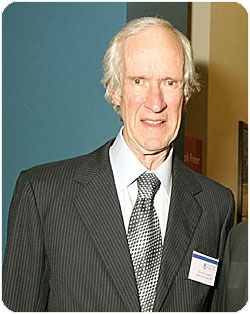 John also received an Honorary Doctorate of Laws in 1993 from the University of Queensland.
John also received an Honorary Doctorate of Laws in 1993 from the University of Queensland.
John acted as Director and Chairman of the Queensland Committee of the Churchill Trust from 1985 to 1992, and was President of the Queensland Art Gallery Society from 1978 to 1982. He was made a Companion in the General Division of the Order of Australia in 1993.
In appearance John seemed somewhat aloof, perhaps due in part to his height and glasses. But that was quite opposite to the real position. He was unfailingly courteous and polite, had great personal charm and a store of experiences to call on. John was a frequent traveller, particularly to Italy and England, and spoke Italian and French. He and his wife of 47 years, Margery, and Mark enjoyed a strong and supportive family relationship. At his swearing in as Chief Justice, John recorded that his “small but cohesive family has always managed to convey to me a sense of solidarity”.
There are two observations which are appropriate to repeat here, both taken from his valedictory address. The first reflects the real respect and the vision he maintained for the role of the Supreme Court:
“The Court’s mission will be entrusted to those who remain and those who, over the years, will join the Bench. It must always be open to new ideas but yet not driven by every wind that blows.”
The second reflects his constancy after a life in the law:
“My feelings are best summed up by saying that although I now think it is time to leave, if I were to start again in life it is the same career I would choose. I would do it all again”.
To those observations should be added a quote from A. C. Grayling, from his introduction to “The Meaning of Things”:
“Socrates famously said that the unconsidered life is not worth living. He meant that a life lived without forethought or principle is a life so vulnerable to chance, and so dependent on the choices and actions of others, that it is of little real value to the person living it. He further meant that a life well lived is one which has goals, and integrity, which is chosen and directed by the one who lives it, to the fullest extent possible to a human agent caught in the webs of society and history.”
John Murtagh Macrossan’s life was indeed a life well lived.
Don Fraser QC
NorthBank Development – Video 1
{youtube}20JK_SkI66M{/youtube}
SEQ Developments — 2008 to 2015
{youtube}ImtIyzSC_Zk{/youtube}
NorthBank Development – Video 2
{youtube}nlSOSlCtpIw{/youtube}
Brisbane Projects 08
{youtube}D6F0BwRMxcA{/youtube}
Indicative perspectives of the new Supreme and District Courts Complex.
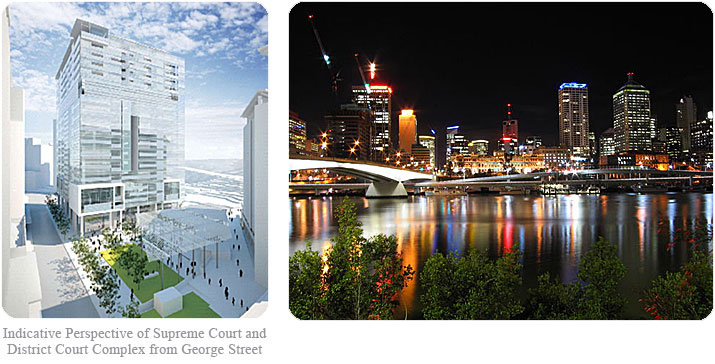
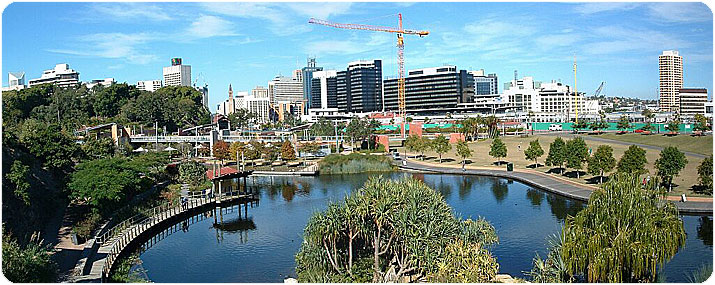

Indicative Perspective from the Public Square
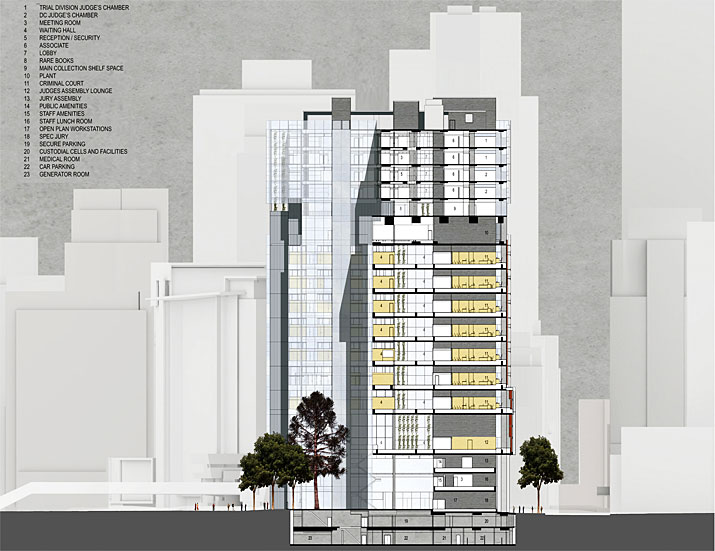
Section from the North
Note: The perspectives featured in this article are indicative only, and are subject to change.


 The first photograph shows the court house. The court room used for the trial is on the top floor, central section with large windows.
The first photograph shows the court house. The court room used for the trial is on the top floor, central section with large windows. The third photograph shows the actual court room as it is now. It was remodelled partially for the war crimes trials and has been remodelled again since then. The crucifix is a feature found in other Bavarian court rooms. Obviously, the doctrine of the separation of Church and State is not entrenched in Bavaria in the way that it is here.
The third photograph shows the actual court room as it is now. It was remodelled partially for the war crimes trials and has been remodelled again since then. The crucifix is a feature found in other Bavarian court rooms. Obviously, the doctrine of the separation of Church and State is not entrenched in Bavaria in the way that it is here.






 The Supreme Court of Queensland was formerly established under the Supreme Court Constitution Amendment Act 1861. Under the provisions of that Act, the Supreme Court of Queensland was to be a court of record to be held at Brisbane and the full powers and legal jurisdiction of the Supreme Court of New South Wales were retrospectively transferred to the Supreme Court of Queensland under the Supreme Court Act 1863.
The Supreme Court of Queensland was formerly established under the Supreme Court Constitution Amendment Act 1861. Under the provisions of that Act, the Supreme Court of Queensland was to be a court of record to be held at Brisbane and the full powers and legal jurisdiction of the Supreme Court of New South Wales were retrospectively transferred to the Supreme Court of Queensland under the Supreme Court Act 1863. In the 1960s, it was decided to replace the original building with a modern multi-story structure but its end was hastened on 1 September 1968 when an arsonist set fire to it with the consequence that much of it was destroyed. This event is the subject of a SCLQ Exhibition currently on display in the Rare Books Precinct on Level 2 of the Complex.
In the 1960s, it was decided to replace the original building with a modern multi-story structure but its end was hastened on 1 September 1968 when an arsonist set fire to it with the consequence that much of it was destroyed. This event is the subject of a SCLQ Exhibition currently on display in the Rare Books Precinct on Level 2 of the Complex.

 The public square will therefore not solely function as an open square between the new Complex and the Magistrates Courts building, it will become the logical termination of the Tank Street pedestrian axis across from Southbank and, as such, will become the marshalling point for what will become the major pedestrian gateway to the CBD.
The public square will therefore not solely function as an open square between the new Complex and the Magistrates Courts building, it will become the logical termination of the Tank Street pedestrian axis across from Southbank and, as such, will become the marshalling point for what will become the major pedestrian gateway to the CBD. Currently over 50,000 people cross the Goodwill Bridge each week and it is expected that at least this number will traverse the Tank Street Bridge and, in the process, walk past the highest courts in the State.
Currently over 50,000 people cross the Goodwill Bridge each week and it is expected that at least this number will traverse the Tank Street Bridge and, in the process, walk past the highest courts in the State.
 John also received an Honorary Doctorate of Laws in 1993 from the University of Queensland.
John also received an Honorary Doctorate of Laws in 1993 from the University of Queensland.


